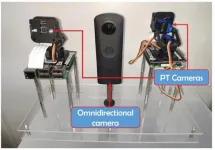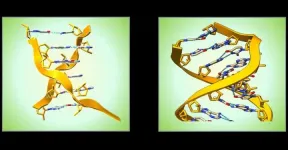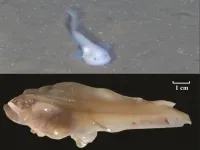(Press-News.org) PROVIDENCE, R.I. [Brown University] -- Since the 1950s, political scientists have theorized that political polarization -- increased numbers of "political partisans" who view the world with an ideological bias -- is associated with an inability to tolerate uncertainty and a need to hold predictable beliefs about the world.
But little is known about the biological mechanisms through which such biased perceptions arise.
To investigate that question, scientists at Brown University measured and compared the brain activity of committed partisans (both liberals and conservatives) as they watched real political debates and news broadcasts. In a recent study, they found that polarization was indeed exacerbated by intolerance of uncertainty: liberals with this trait tended to be more liberal in how they viewed political events, conservatives with this trait tended to be more conservative.
Yet the same neural mechanisms was at work, pushing the partisans into their different ideological camps.
"This is the first research we know of that has linked intolerance to uncertainty to political polarization on both sides of the aisle," said study co-author Oriel FeldmanHall, an assistant professor of cognitive, linguistic and psychological sciences at Brown. "So whether a person in 2016 was a strongly committed Trump supporter or a strongly committed Clinton supporter, it doesn't matter. What matters is that an aversion to uncertainty only exacerbates how similarly two conservative brains or two liberal brains respond when consuming political content."
Jeroen van Baar, study co-author and a former post-doctoral researcher at Brown, said the findings are important because they show that factors other than political beliefs themselves can influence individuals' ideological biases.
"We found that polarized perception -- ideologically warped perceptions of the same reality -- was strongest in people with the lowest tolerance for uncertainty in general," said van Baar, who is now a research associate at Trimbos, the Netherlands Institute of Mental Health and Addiction. "This shows that some of the animosity and misunderstanding we see in society is not due to irreconcilable differences in political beliefs, but instead depends on surprising -- and potentially solvable -- factors such as the uncertainty people experience in daily life."
The study was published online in the journal PNAS on Thurs., May 13.
To examine whether and how intolerance for uncertainty shapes how political information is processed in the brain, the researchers recruited 22 committed liberals and 22 conservatives. They used fMRI technology to measure brain activity while participants watched three types of videos: a neutrally worded news segment on a politically charged topic, an inflammatory debate segment and a non-political nature documentary.
After the viewing session, participants answered questions about their comprehension and judgment of the videos and completed an extensive survey with five political and three cognitive questionnaires designed to measure traits like intolerance of uncertainty.
"We used relatively new methods to look at whether a trait like intolerance of uncertainty exacerbates polarization, and to examine if individual differences in patterns of brain activity synchronize to other individuals that hold like-minded beliefs," FeldmanHall said.
When the researchers analyzed participants' brain activity while processing the videos, they found that neural responses diverged between liberals and conservatives, reflecting differences in the subjective interpretation of the footage. People who identified strongly as liberal processed political content much in the same way and at the same time -- which the researchers refer to as neural synchrony. Likewise, the brains of those who identified as conservative were also in sync when processing political content.
"If you are a politically polarized person, your brain syncs up with like-minded individuals in your party to perceive political information in the same way," FeldmanHall said.
This polarized perception was exacerbated by the personality trait of intolerance of uncertainty. Those participants -- of any ideology -- who were less tolerant to uncertainty in daily life (as reported on their survey responses) had more ideologically polarized brain responses than those who are better able to tolerate uncertainty.
"This suggests that aversion to uncertainty governs how the brain processes political information to form black-and-white interpretations of inflammatory political content," the researchers wrote in the study.
Interestingly, the researchers did not observe the polarized perception effect during a non-political video or even during a video about abortion presented in a neutral, non-partisan tone.
"This is key because it implies that 'liberal and conservative brains' are not just different in some stable way, like brain structure or basic functioning, as other researchers have claimed, but instead that ideological differences in brain processes arise from exposure to very particular polarizing material," van Baar said. "This suggests that political partisans may be able to see eye to eye -- provided we find the right way to communicate."
INFORMATION:
David J. Halpern of New York University and the University of Pennsylvania was an additional study author.
The research was supported by a Brown University seed grant and by National Institutes of Health COBRE Grant P20GM103645.
If you're a fan of spy movies, you've probably come across scenes where the intelligence agents try to identify or detect a perpetrator using some sophisticated image enhancement technology on surveillance camera images. While the idea behind surveillance cameras and object detection is the same in real life, unlike in movies, there is often a trade-off between the camera's field-of-view and its resolution.
Surveillance cameras are typically required to have a wide field-of-view to make the detection of a threat more likely. Due to this, omnidirectional ...
The first frost of autumn may be grim for gardeners but the latest evidence reveals it is a profound event in the life of plants.
The discovery may affect how we grow crops in a fluctuating climate and help us better understand molecular mechanisms in animals and humans.
Much of our understanding of how plants register temperature at a molecular level has been gained from the study of vernalization - the exposure to an extended period of cold as a preparation for flowering in spring.
Experiments using the model plant Arabidopsis have shown how this prolonged period of cold lifts the brake on flowering, a gene called FLC. This biochemical brake also involves another molecule COOLAIR which is antisense to FLC. This means it lies on the ...
Researchers at Hospital for Special Surgery (HSS) have identified gaps in patient knowledge about pain management and opioid use before total hip replacement, including misconceptions about how much pain relief to expect from opioids after surgery, how to use multiple modes of pain relief (multimodal analgesia) safely and effectively, and proper opioid storage and disposal. These findings were presented at the 2021 Spring American Society of Regional Anesthesia and Pain Medicine (ASRA) Annual Meeting.1
"Patients who are not taught about opioids and pain management may have difficulty with pain control and worse functional outcomes after total ...
Researchers at Hospital for Special Surgery (HSS) have identified risk factors for persistent opioid use after surgery in pediatric patients.1 Study findings were presented at the 2021 Spring American Society of Regional Anesthesia and Pain Medicine (ASRA) Annual Meeting.
Previous research indicates that prescription patterns for opioids after surgery in children and adolescents may be associated with long-term use and abuse.2
"Pediatric patients have developing brains that are uniquely vulnerable to addiction, and we need to learn to treat their pain safely without putting them at additional ...
In a study carried out in mice at the University of Chicago, researchers found that lasofoxifene outperformed fulvestrant, the current gold-standard drug, in reducing or preventing primary tumor growth. It also was more effective at preventing metastasis in the lung, liver, bone and brain, the four most common areas for this cancer to spread.
Additionally, while fulvestrant and similar drugs often cause unwanted, menopausal-like side effects, lasofoxifene prevents some of these symptoms. The research was published on May 13 in END ...
How people consume news and take actions based on what they read, hear or see, is different than how human brains process other types of information on a daily basis, according to researchers at the University of Missouri School of Journalism. While the current state of the newspaper industry is in flux, these journalism experts discovered people still love reading newspapers, and they believe a newspaper's physical layout and structure could help curators of digital news platforms enhance their users' experiences.
"Many people still love print newspapers, and to an extent, we also see that they like the digital replicas of print newspapers as much as they do the physical version," said Damon Kiesow, a professor of journalism professions and co-author on the study. "But we believe there ...
In a paper published in the May 13th, 2021 issue of PLOS Genetics, a Z-RNA nanoswitch that regulates interferon immune responses is described. The switch, less than 5 nanometer in length, is based on sequences, called flipons, that change outcomes by altering their three dimensional conformation. The Z-RNA nanoswitch flips from the shorter right-handed A-RNA helix ("on") to the longer left-handed Z-RNA helix ("off"). The flip ends immune responses against self RNAs, but not against viruses. Surprisingly, the Z-RNA nanoswitch sequence is encoded by "junk DNA". The Z-RNA nanoswitch is used by some cancers to silence anti-tumor immune responses. In other cases, a malfunction of the Z-RNA nanoswitch causes inflammatory disease.
In the ...
A new strategy for capturing the 3D shape of the human face draws on data from sibling pairs and leads to identification of novel links between facial shape traits and specific locations within the human genome. Hanne Hoskens of the Department of Human Genetics at Katholieke Universiteit in Leuven, Belgium, and colleagues present these findings in the open-access journal PLOS Genetics.
The ability to capture the 3D shape of the human face--and how it varies between individuals with different genetics--can inform a variety of applications, including understanding human evolution, planning for surgery, and forensic sciences. ...
Mutations in two genetic regions in dogs explain over one third of the risk of developing an aggressive form of hematological cancer, according to a study led by Jacquelyn Evans and Elaine Ostrander at the National Human Genome Research Institute in Maryland, USA and colleagues. The study, which combined multiple sequencing techniques to investigate histiocytic sarcoma in retriever dogs, publishes May 13 in the open-access journal PLOS Genetics.
Histiocytic sarcoma is an aggressive cancer of immune cells, and although extremely rare in humans, it affects around one-in-five flat-coated retrievers. Genome-wide association surveys of 177 affected and 132 unaffected flat-coated ...
A new whole genome sequence for the Yap hadal snailfish provides insights into how the unusual fish survives in some of the deepest parts of the ocean. Xinhua Chen of the Fujian Agriculture and Forestry University and Qiong Shi of the BGI Academy of Marine Sciences published their analysis of the new genome May 13th in the journal PLOS Genetics.
Animals living in deep-sea environments face many challenges, including high pressures, low temperatures, little food and almost no light. Fish are the only animals with a backbone that live in the hadal zone--defined as depths below 6,000 meters--and hadal snailfishes live in at least five separate marine trenches. Chen, Shi and their colleagues constructed a high-quality whole genome sequence from the Yap ...



